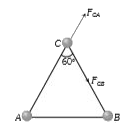Electric charge of 1μC,−1μC and 2μC are placed in air at the corners A, B and C respectively of an equilateral triangle ABC having length of each side 10 cm. The resultant force on the charge at C is
0.9 N
1.8 N
2.7 N
3.6 N
The correct Answer is:B
r = 0.1m
Fnet=√F2CA+F2CB+2FCA.FCBcos120
=√F2+F2+2F2(−1/2)=F

∴F=KqAqcr2=9×109×1×2×10−12(0.1)2=1.8N
Similar Questions
Charges of +2 +2, and −2μC respectively are placed at the vertices of an equilateral triangle of side 0.3m each in Find the net forces experienced by each charges.
View SolutionFour point charges q_(A) =2 muC, q_(B) = -5 muC, q_(C) =2 muC , and q_(D) = -5 muC are located at the corners of a square ABCD of side 10 cm. What is the force on a charge of 1 muC placed at the centre of the square ?
View SolutionElectric charge of 1μc,−1μCandμc are placed in air at the corners A,B and C respectively of an equilateral triangle ABC having length of each side 10 cm .The resultant force on the charge at C is
View SolutionElectric charges of 1muC , -1muC and 2muC are placed in air at the corners A, B and C reepectively of an equilateral triangle ABC having length of each side 10cm. The resultant force on the charge at C is
View SolutionThere charges , each of +1 muC , are placed at the corners of an equilateral triangle. If the force between any two charges be f, then the net force on either charges will be :
View SolutionElectric charge of 1μc,−1μc and 2μc are placed in air at the corners A,B and C respectively of an equilateral triangle ABC having length of each side 10 cm . The resultant force on the charge at C is
View SolutionElectric charge of 1μC,−1μC and 2μC are placed in air at the corners A, B and C respectively of an equilateral triangle ABC having length of each side 10 cm. The resultant force on the charge at C is
View SolutionThree charges are placed at the vertices of an equilateral triangle of side 10 cm. Assume q1=1μC,q2=−2μCandq3=4μC. Work done in separating the charges to infinity is
View Solution